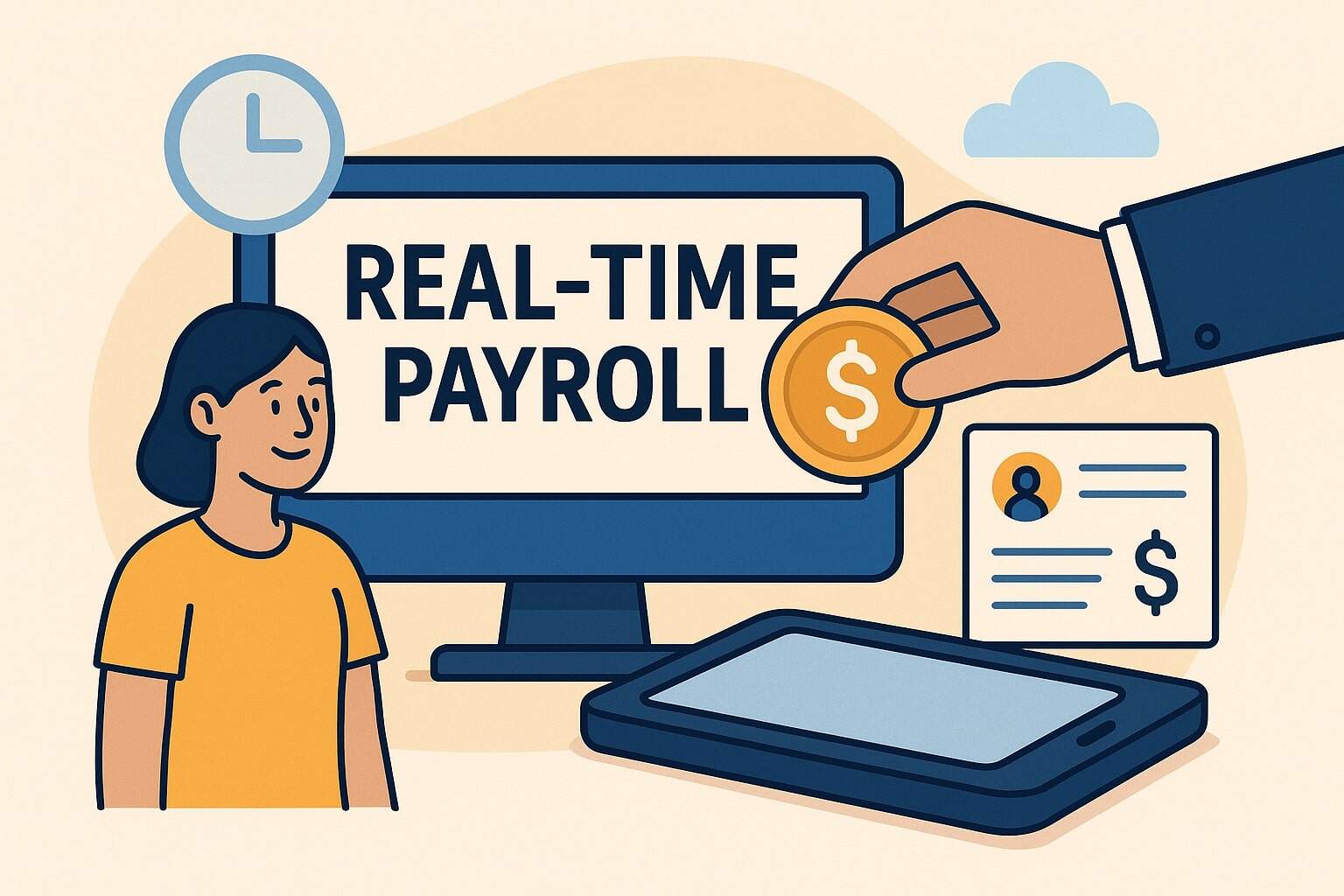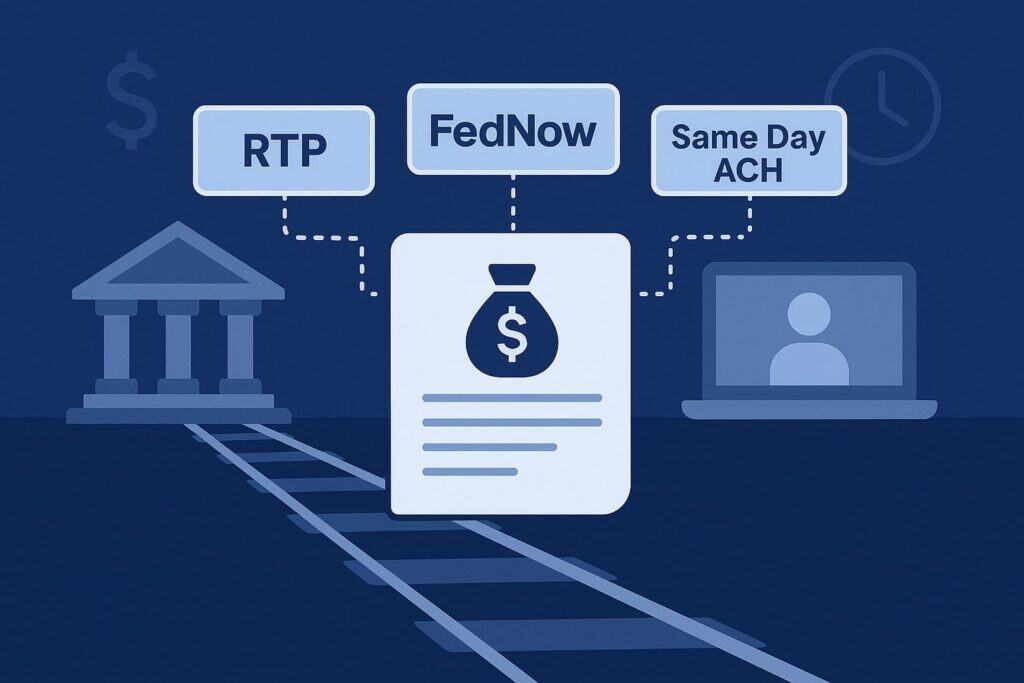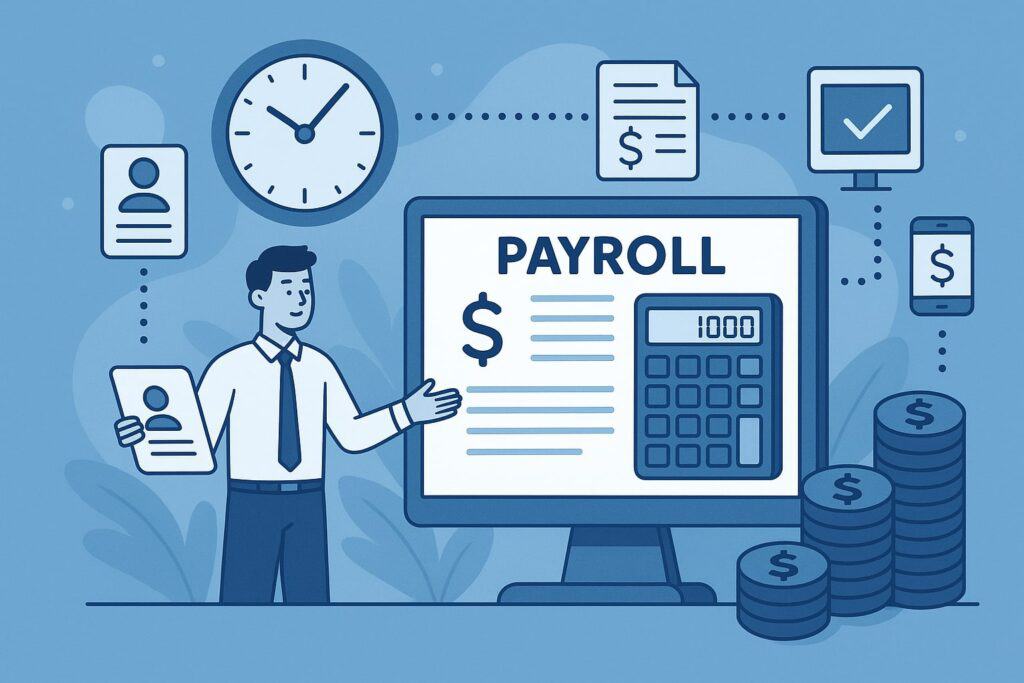
Real-Time Payroll: How Businesses Are Paying Employees Instantly
Real-time payroll is the ability to pay employees instantly—or within seconds—directly to their bank account, paycard, or wallet, any day, any time.
Unlike traditional payroll cycles that rely on batch ACH files, overnight processing, and bank cutoffs, real-time payroll leverages instant payment rails and modern payroll orchestration to move funds 24x7x365.
For U.S. employers, the benefits are compelling: reduced employee financial stress, fewer paper checks, leaner payroll operations, and better workforce retention.
The timing is right because the U.S. finally has ubiquitous instant payment infrastructure at scale: The Clearing House RTP® network (live since 2017) and the Federal Reserve’s FedNow® Service (live since July 20, 2023).
Both rails provide immediate funds availability and immediate confirmation—unlocking new “on-demand pay” models, shift-end payouts, emergency disbursements, and off-cycle bonuses without waiting for the next pay date.
The Rails Powering Real-Time Payroll: RTP, FedNow, and Same Day ACH

Two true instant rails now serve U.S. businesses. RTP® from The Clearing House and FedNow® from the Federal Reserve both settle in (near) real time, are available 24x7x365, and provide finality and immediate credit push capability that’s well-suited to payroll and earned wage access.
RTP supports features like Request for Payment (RfP), which lets a platform request an employee’s bank to push funds instantly after approval—useful for reimbursements or contractor payouts.
FedNow offers round-the-clock availability with strong settlement controls, making it attractive for banks that want native instant experiences for business customers.
Same Day ACH, while not “instant,” is also crucial: it enables same-day crediting within banking days and now supports up to $1 million per payment, expanding its usefulness for off-cycle payroll and high-value payouts.
In practice, many employers combine these rails: instant when immediacy is required; Same Day ACH for same-day settlement during banking hours; and next-day ACH for standard cycles.
How Real-Time Payroll Actually Works (Step-by-Step)

- Gross-to-net calculation still comes first. Your HCM/payroll system calculates each employee’s gross pay, deductions, taxes, garnishments, and net pay using IRS rules (Pub. 15, 15-T) and state guidance.
- Payment rail selection: Your payroll engine chooses RTP, FedNow, Same Day ACH, paycard load, or a mix—based on employee preference, bank support, cost, timing, and value.
- Funding & risk: For instant rails, the employer or processor typically pre-funds or uses just-in-time funding from an associated settlement account.
- Payment initiation: The system submits credit-push payments to employees’ accounts and obtains immediate confirmations on instant rails.
- Posting & receipt: Employees see funds within seconds on RTP/FedNow, usually with a descriptive payroll memo line.
- Compliance & reporting: Payroll files still need tax deposits, quarterly filings, and W-2 reporting—regardless of speed.
Importantly, supplemental wages and bonuses paid instantly still follow federal withholding rules (e.g., the 22%/37% federal supplemental withholding framework).
The Regulatory Landscape Employers Must Know in 2025

Real-time payroll doesn’t change your obligations under federal wage-and-hour, tax, and electronic transfer rules. The FLSA still governs minimum wage, overtime, and recordkeeping, and requires payment in cash or its equivalent; it does not set pay frequency, so state payday laws fill that gap.
If you use paycards, Regulation E (EFTA) applies—employees can’t be forced to receive wages on a payroll card, and they get core protections like error resolution and access to account information.
For on-demand pay (earned wage access), the CFPB in July 2024 proposed an interpretive rule signaling that many EWA/paycheck advance products are consumer loans under TILA/Reg Z, requiring disclosures of fees and costs.
States are also active: several have passed or are considering EWA and pay-transparency laws, so multistate employers should monitor evolving requirements closely.
Taxes and Withholding: Instant Doesn’t Mean “Optional”
Whether you pay weekly, daily, or instantly after a shift, federal (and state) tax rules still apply. Employers must use current IRS guidance for FITW calculation (Publications 15 and 15-T) and deposit schedules.
Supplemental wage rules matter for real-time bonus or incentive disbursements: up to $1 million, a flat 22% federal rate can be used; above $1 million, 37% mandatory withholding applies.
FICA (Social Security, Medicare) still applies, with annual wage bases and rates updated each year. In 2025, Social Security’s wage base is $176,100, with 6.2% each from employer and employee; Medicare remains 1.45% each (plus Additional Medicare Tax where applicable).
Your system must also respect state supplemental rates and local taxes. Instant rails change the timing of pay, not your tax compliance duties.
State Payday Rules and Pay Frequency—Designing a Compliant Instant Cycle
Federal law doesn’t dictate how often you must pay; states do. If your strategy involves daily or on-demand pay, you must still satisfy each state’s minimum pay-frequency and final-pay rules. Many states require at least semimonthly or biweekly payments; some mandate weekly for certain industries.
The safest approach is to layer instant access on top of a compliant base schedule (e.g., biweekly payroll remains the official pay period for statements/taxes, while employees can draw earned wages instantly between paydays).
Maintain consistent, published policies and ensure final pay on termination meets state timelines—even if you use instant rails to meet same-day final pay obligations in strict jurisdictions. Always document the “official payday” for wage statements, even when providing real-time access to earnings.
RTP vs. FedNow vs. Same Day ACH vs. Paycards: Picking the Right Rail
RTP offers instant clearing, irrevocability, and rich messaging (including RfP), making it strong for shift-end payouts and emergency disbursements.
FedNow broadens access via the Federal Reserve’s network, creating more bank options over time; it’s always-on with settlement in seconds, backed by Fed accounting and security controls.
Same Day ACH helps when instant rails aren’t available or cost-effective, or when you’re operating within banking hours; its $1 million limit makes it viable for higher-value off-cycle payroll.
Paycards are useful for unbanked or underbanked workers; just ensure Reg E compliance and offer a choice (bank account/direct deposit alternative must be available).
In practice, many employers route most scheduled payroll through ACH and reserve instant rails for exceptions, on-demand draws, bonuses, and corrections that can’t wait.
Building a Real-Time Payroll Stack (People, Process, Platform)
To make real-time payroll work at scale, align your HCM/payroll platform, banking partners, and payment gateways. Pick providers that support RTP and FedNow natively and can fail over to Same Day ACH when an employee’s bank isn’t reachable on instant rails.
Establish clear funding workflows (e.g., prefunding a settlement account each morning), limit management, and exception handling for returns or name/number mismatches. Create an eligibility matrix: who can receive instant pay, to which destination (DDA, paycard), with what limits, and what fees (if any).
Finally, tune your controls: multi-factor approvals for batch releases, strong payee validation, SOC-audited change controls, and robust audit trails—because instant is great only if it’s accurate and compliant.
Fraud, Risk, and Controls in an Always-On World
Instant payouts compress the time you have to detect errors and fraud. Adopt positive payee and account-name matching where available. Use velocity controls (per-employee per-day caps), device/behavioral risk signals, and strict user entitlements for payroll admins.
Require dual approval for off-cycle and high-value batches. Leverage RTP/FedNow confirmations to reconcile instantly; if a payment fails on an instant rail, auto-fallback to Same Day ACH or queue for manual review.
Educate employees about phishing and payroll diversion schemes, and maintain a fast path to reverse erroneous entries where possible (note that RTP is irrevocable, so prevention and pre-validation are paramount).
Industry studies show instant-payment adoption is rising quickly, making disciplined risk management a core competency for payroll teams.
Earned Wage Access (On-Demand Pay): What’s Changing in 2025
EWA lets employees access a portion of accrued wages before payday, delivered to their bank, paycard, or wallet—often instantly. The compliance line is evolving.
In July 2024, the CFPB proposed an interpretive rule stating many paycheck advances/earned wage products are credit under TILA/Reg Z, requiring cost disclosures and other protections.
States continue to pass EWA-specific laws or guidance, sometimes diverging from federal perspectives; watch rulemaking calendars and licensing requirements.
For employers, key practices include: partner with providers that disclose all fees clearly; obtain employee opt-in; cap advances to accrued wages; and ensure real-time payroll flows do not create inadvertent loans, wage assignments, or tip credit issues. Document each transaction in payroll records to maintain accurate year-end reporting.
Employee Experience: Designing Payout Choices that Workers Love
The best real-time payroll programs are employee-centric. Offer simple choices: direct deposit to bank, instant credit push when available, or paycard; make fees (if any) transparent; allow employees to change destinations securely; and provide clear pay statements even when funds are delivered continuously.
Communicate how taxes and deductions are handled for instant bonuses, commissions, or per-diem reimbursements. Provide in-app confirmations so workers know the money arrived, and include financial wellness content to help employees avoid overdrafts or unnecessary fees.
The combination of speed + clarity builds trust, reduces HR tickets, and strengthens retention—especially among hourly workforces and 1099 contractors who value flexibility and liquidity.
Cost Modeling: What to Budget for Real-Time Payroll
Expect a mix of per-payment fees on instant rails, potential settlement/funding charges, and platform fees for orchestration. Many employers reserve instant rails for time-sensitive use cases to control cost, while routing standard payroll via ACH.
Factor in implementation (bank onboarding, file formats, sandbox testing), risk tooling (account validation, monitoring), and support (employee success).
Balance direct costs against benefits: fewer check reissues, fewer next-day corrections, improved recruiting and retention, and lower financial stress for employees (which correlates with productivity).
Instant capability also reduces payroll breakage—the operational overhead from missed cutoffs, holidays, and emergency off-cycles that used to trigger expensive manual work.
Implementation Roadmap: A 90-Day Playbook
Days 0–30: confirm business cases (on-demand pay, off-cycle fixes, emergency disbursements), select rails and providers, and map compliance requirements (Reg E, FLSA, state payday rules).
Days 31–60: build integrations, configure funding, set limits and approvals, test with pilot groups, and validate tax handling for supplemental wages and bonus flows per Pub. 15-T.
Days 61–90: expand gradually, add contractors and remote states, finalize incident runbooks (fallback to Same Day ACH), and publish policies and employee education. Throughout, track KPIs: payout success rate, time-to-wallet, cost per payout, support tickets, and employee NPS.
Legal & Policy Guardrails Checklist (U.S.)
- FLSA compliance: pay at least minimum wage; pay overtime correctly; maintain records; pay in cash or equivalent.
- State payday rules: meet minimum pay frequency and final pay timing; set an “official payday” even with instant access.
- Payroll cards: ensure voluntariness and Reg E protections; post disclosures and error-resolution processes.
- EWA/on-demand pay: treat products that resemble credit as subject to TILA/Reg Z; ensure transparent fees.
- Taxes: follow 2025 Pub. 15/15-T; apply 22%/37% supplemental rules; deposit timely.
- Rails policy: define when to use RTP/FedNow vs Same Day ACH; document fallback paths; monitor risk continuously.
Real-Time Payroll Use Cases You Can Launch Now
- Shift-end pay for hourly teams to reduce turnover and improve fill rates for open shifts.
- Instant sign-on bonuses/spot awards for recruiting and retention.
- Emergency relief payments during outages, natural disasters, or payroll errors.
- On-demand access to earned wages with caps (e.g., 50–70% of accrued net) and fee transparency.
- Contractor and gig payouts on acceptance or milestone completion.
- Final wages at termination in states with strict timelines—using instant rails to meet same-day obligations.
Metrics That Prove Real-Time Payroll ROI
Track time-to-wallet, payout success rate, support tickets per 1,000 payouts, cost per payout by rail, employee NPS, and retention/absenteeism before vs. after. Watch error rates and adjustment volumes; instant mechanisms can reduce reissues and overnight file failures.
As adoption grows, use A/B tests to compare retention for teams with on-demand pay vs. traditional schedules. Insights from national groups like the U.S. Faster Payments Council shows that broader instant-payment adoption correlates with expanded use cases and operational confidence.
Practical Compliance Tips for U.S. Employers
- Publish an official payday that satisfies state rules, even if employees can draw funds early.
- Document consent and destinations (bank, paycard) and allow changes with MFA.
- Honor Reg E for payroll cards; never require a card as the only option.
- Apply 2025 IRS rules for all wages (scheduled or instant) and deposit on time.
- Vet EWA providers for TILA/Reg Z readiness and state licensing where applicable.
- Train HR/payroll admins on real-time exception handling.
- Run pilots in a few states before scaling nationwide.
Frequently Asked Questions (FAQs)
Q.1: Is real-time payroll legal in the U.S.?
Answer: Yes—if you still meet federal and state wage, tax, and recordkeeping rules. The FLSA requires payment in cash or its equivalent and proper minimum wage/overtime.
States set pay frequency and final-pay rules; you can provide instant access in addition to a compliant base schedule. Taxes and reporting remain unchanged—you’re just moving the money faster.
Q.2: Do instant payments change my tax withholding?
Answer: No. Instant payments don’t alter the rules. Use 2025 IRS guidance (Pub. 15/15-T). For supplemental wages like bonuses or shift-end incentives, you may use the 22% flat rate up to $1 million and 37% above $1 million. Deposit and report on the normal timelines.
Q.3: Which rail should I use for payroll—RTP, FedNow, Same Day ACH, or paycards?
Answer: Use RTP or FedNow for payments that can’t wait (shift-end, corrections, emergencies). Use Same Day ACH for same-day settlement during banking hours or when an employee’s bank isn’t on instant rails.
Maintain paycards for workers without bank accounts (with Reg E protections). Most employers blend rails to balance speed and cost.
Q.4: What about earned wage access—are there new rules?
Answer: In July 2024, the CFPB proposed guidance stating many EWA/paycheck advances are consumer loans under TILA/Reg Z, triggering disclosures and other protections.
Several states have passed or are considering EWA-specific legislation. Work with providers that comply with disclosure and licensing requirements, and structure plans to avoid lending risk.
Q.5: Can I pay contractors instantly too?
Answer: Yes. Instant rails are well-suited for 1099 payouts and per-gig payments. Remember: contractor tax reporting (e.g., 1099-NEC) is separate from employee W-2 payroll, but the payment mechanisms can be the same. Confirm bank support for RTP/FedNow and maintain strong payee validation.
Q.6: Are instant payroll payments reversible if I make a mistake?
Answer: RTP and FedNow payments are final once sent, so prevention is key. Implement robust pre-validation, approval workflows, and name/number verification. Keep a fallback path (e.g., Same Day ACH) for cases where you prefer easier exception handling.
Q.7: How widespread is instant payroll adoption?
Answer: Adoption is accelerating. Research from the U.S. Faster Payments Council (2024) indicates strong growth expectations across financial institutions and third-party enablers through 2028, as banks expand RTP and FedNow capabilities and businesses embed instant payouts into HCM tools.
Conclusion
Real-time payroll turns compensation into a strategic differentiator. With RTP and FedNow in production, employers can pay people when it matters, not just when the calendar says so. Your responsibilities—FLSA, state payday rules, Reg E, and tax withholding—remain the same; the difference is speed, control, and employee trust.
Start by enabling instant rails for urgent use cases, wrap them with clear policies and controls, and scale thoughtfully. The organizations that master real-time payroll in 2025 will attract talent faster, reduce financial stress across their teams, and run a tighter, more resilient back office.